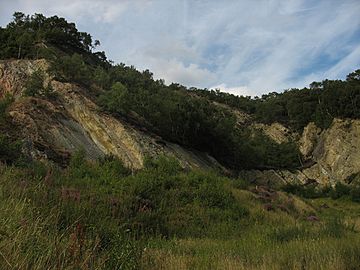The Ercall facts for kids
Quick facts for kids The Ercall |
|
|---|---|

The Ercall's quarries viewed from the south.
|
|
| Highest point | |
| Elevation | 140 m (460 ft) (approx.) |
| Geography | |
| Location | Shropshire, England |
| Parent range | Shropshire Hills |
| OS grid | SJ643096 |
The Ercall, also known as Ercall Hill, is a small hill in Shropshire, England. It is located between The Wrekin and Wellington, in the Telford & Wrekin area.
The Ercall is a very important place for studying geology, which is the science of Earth's rocks and history. It is part of a special protected area called a Site of Special Scientific Interest (SSSI). The Shropshire Wildlife Trust helps to look after the hill.
At The Ercall, you can see rocks that are 540 million years old. These rocks even have ripple marks from ancient seas! There are also old lava flows from a time called the Precambrian era, visible in old quarries. You can also spot Quartzite rock from the nearby Wrekin hill. People used to dig out rocks from The Ercall in large quarries. These quarries are not used anymore, but they are safe and open for everyone to explore. When the M54 motorway was built in 1974, it went right through the northern part of the hill.
Contents
Animals and Plants of The Ercall
The woods on The Ercall are home to many different kinds of butterfly species.
Butterflies of The Ercall
In the summer, the Ercall Woods are a favorite spot for the speckled wood butterfly. During spring, when the woods are full of beautiful bluebells, you might see many dingy skipper butterflies. The old quarries, which are open and sunny, are also popular with other butterflies. These include the green hairstreak and the wall butterfly, which like to warm themselves in sheltered spots.
Trees and Other Plants
On the higher parts of the hill, you will mostly find tall oak trees. The soil here is a bit acidic, which means special plants like bilberry, climbing corydalis, and heath bedstraw can grow well. You might also hear or see the green woodpecker in these woods.
How to Visit The Ercall
Visiting The Ercall is similar to getting to The Wrekin nearby.
Getting There by Car
If you are driving on the M54 motorway, take the last exit at Junction 7. If you are on the A5 road coming from Shrewsbury, take the last junction before it turns into the M54. From there, you will see signs pointing to The Wrekin. Follow this road until you reach The Wrekin, then look for the sign for the Buckatree Hotel.
Parking and Entrance
There is a small car park right across the road from the Buckatree Hotel. The entrance to The Ercall is easy to see from there.
The Geology of The Ercall
The Ercall Quarries are a SSSI, so it's important to be careful and respectful when you explore this area. When you enter the quarry from the main path near The Wrekin, you will find an old quarry with many interesting rock features.
Ancient Volcanic Rocks
This first quarry shows rocks from a time called the Precambrian era. These rocks are from ancient volcanoes and are known as Uriconian Volcanic deposits. Scientists think these volcanoes were very active and might have been near a place where Earth's plates were pushing together. The way the rocks look suggests they cooled down quickly, possibly underwater. Over millions of years, the sea levels changed, so the area might have been sometimes underwater and sometimes above it.
Different Rock Types
In the quarry, you can see a dark grey rock called a dolerite dyke. A dyke is like a wall of rock that pushed its way up through older rocks. This dolerite dyke cut through the Uriconian Rhyolite rock. Rhyolite is another type of volcanic rock that came from explosive volcanoes to the west of this area.
You can also see a clear difference between the dark brown, black, or grey volcanic rocks and a pink rock called granophyre. The granophyre pushed into the volcanic rocks, which means it is younger than them.
Cambrian Rocks and Folding
Above the granophyre, there are Cambrian rocks that are much younger. These rocks contain fossils from the Atdabanian age. The granophyre itself is about 560 million years old and is linked to the volcanic activity in the area. The heat from these events likely helped create a basin where sediments collected. Later, these layers of rock were folded, creating the steep slopes you can see today, like at the Forest Glen car park. This folding event is thought to have happened around 526 million years ago.

